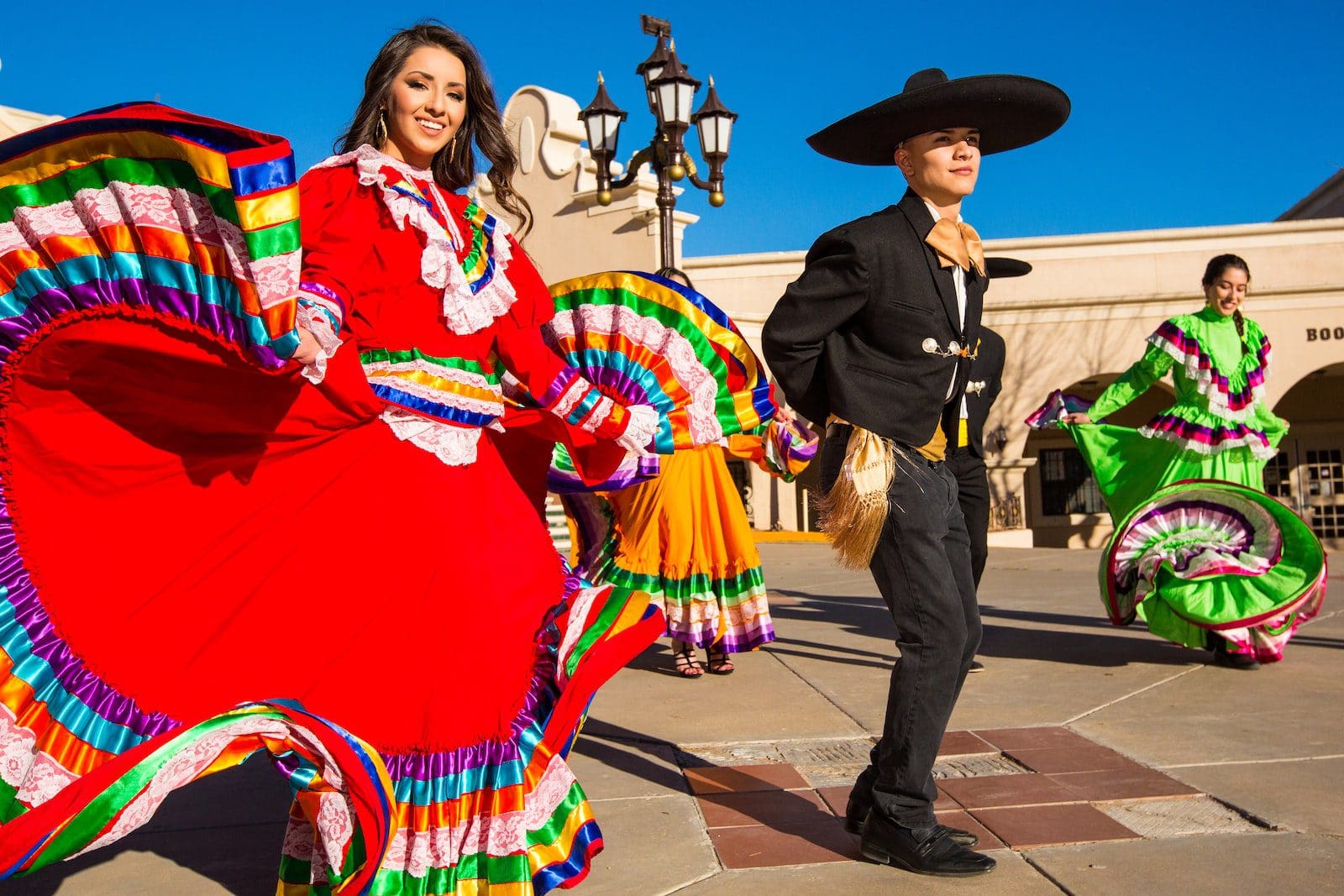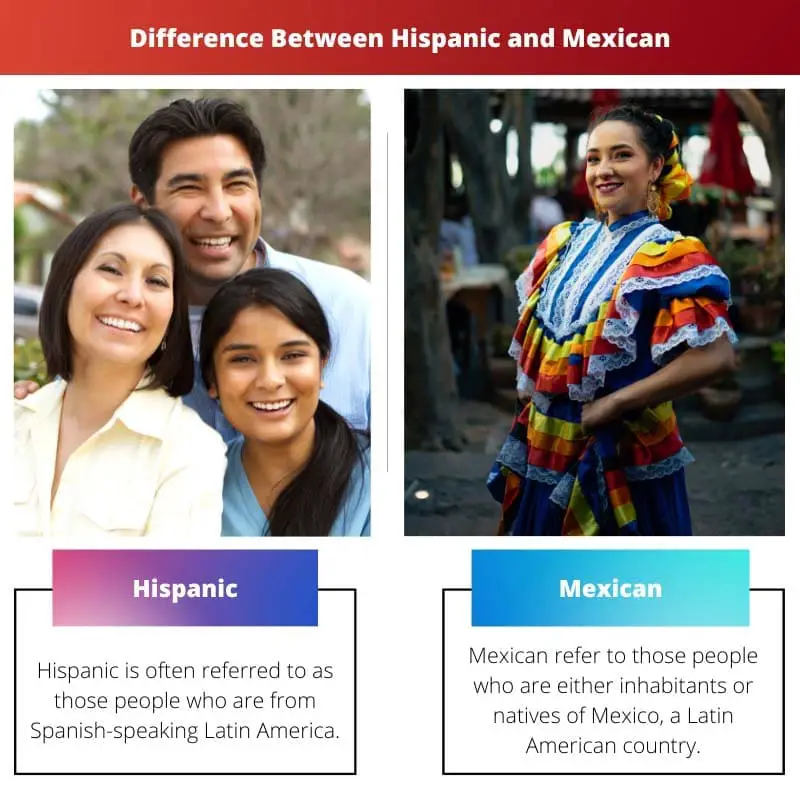It is not easy to distinguish between Hispanic and Mexican people without knowing their history.
Hispanic people are a very diverse and large group and Mexicans can also be a part of the community whereas Mexican is a nationality that puts a certain geographical boundary to the population.
Hispanics are found in several nations, unlike Mexicans.
Key Takeaways
- Hispanic refers to people who share a Spanish-speaking cultural background, while Mexican refers specifically to people from Mexico.
- Hispanic can encompass various nationalities and ethnicities, while Mexican is a more precise term for people with Mexican heritage.
- Both terms are used to describe cultural identities and backgrounds but are not interchangeable.
Hispanic vs Mexican
The term Hispanic refers to people who come from, or have ancestry from, Spanish-speaking countries. This includes countries such as Spain, Mexico, Cuba, and many others. Mexican refers specifically to people who come from or have ancestry from Mexico, which is a country in North America. Mexicans have their own unique culture, language (Spanish), and traditions.

Hispanic people are also sometimes recognized as Latino and the community comprises of multiple races. The Hispanic population is maximum in Spanish-speaking countries like Mexico, Puerto Rico, Cuba, South, and Central America.
Hispanics make up one-sixth of the total US population approximately and it is the largest ethnic minority group in the nation.
Mexican people are native to the land of Mexico that was originally a part of the Spanish Empire until the early 1800s. This is one of the reasons why Spanish is the most popular language in Mexico.
Mexican people have witnessed a rapid rise in population during the 20th century which was mostly due to good food supply and improved healthcare.
Comparison Table
| Parameters of Comparison | Hispanic | Mexican |
|---|---|---|
| Definition | Hispanic is referred to as those people who are from Spanish-speaking Latin America. | Mexican refer to those people who are either inhabitants or natives of Mexico, a Latin American country. |
| Order | All Hispanics are not Mexicans. | A Mexican can be referred to as a Hispanic. |
| Origin | Hispanics are a more diverse community that includes any Spanish-speaking countries from Mexico to Puerto Rico. | Since Mexico was a part of the Spanish Empire till 1810, most Mexican will find their origin in Spain. |
| Language | All Hispanics can speak Spanish. | All Mexicans may or may not speak Spanish. |
| Significance | Hispanic are called such based on whether they are from Spanish-speaking countries, thus giving more importance to the language. | Mexican people are called so based on their geographical status. |
| Population | Most of the Hispanic population is concentrated in Mexico, Puerta Rico, and Cuba. | Mexico and the United States have the highest number of Mexicans. |
| Food | Mostly known as Mexican, tacos are famous Hispanic food. | Chilaquiles is one of the most popular Mexican foods and its national dish is Mole Poblano. |
Who is Hispanic?
Hispanics, with time, have traveled and settled in various parts of the world. A major part of the population in the US is also comprised of the Hispanic community who have settled and lived in the country for generations.
Though Hispanics are a minority group in the US, they are also the fastest-growing ethnic minority group in the country. Half the increase in population in the US
between 2000 and 2010 was due to the rapid increase in the population of Hispanics.
Those people who have Spanish as their first or second language are considered Hispanics. They define a very diverse group of people that include people of European ancestry, Africans, as well as native Americans.
Today, if the origin of Hispanic Americans is traced, their roots can be found spread in more than 20 countries. Among all the nations where Hispanics are inhabiting today, the majority of the population resides in Mexico and Puerto Rico.
After these two nations, Cuba and Salvadora also have a good number of Hispanics.
Roman Catholicism is the most common religion among Hispanics. In the United States, after catholicism, protestant is the second-most popular religion among the Hispanics and almost 13% of the population has no affiliation.
The language retention rate (Spanish here) among Hispanics varies geographically.

Who is Mexican?
In Mexico, the Mexican population has surpassed 120 million after entering a few years into the 21st century. But at the same time, many Mexicans are also immigrating to the US both legally and illegally.
Among various immigrant groups in the US, Mexicans are the largest one. Most of these Mexican immigrants move to the US for better work opportunities.
The Mexican government has a framework of a federal presidential representative democratic republic that has three branches, executive, legislative, and judicial.
Mexican women didn’t have the right to participate in local elections until 1947.
Mexico is one of the nations in Latin America that has significantly improved its economic condition since the 1970s. Various trading and transportation services contribute largely to the GDP of the Mexican economy.
Many Mexican people are also involved in the agricultural and financial sectors.
The main transformation in the Mexican economy started taking place in the 1980s as before that the Mexican government strictly prohibited any private investors from ownership in various industries.
One-fifth of the total Mexican population is invested in agriculture and the chief crops include corn, sugarcane, chilies, oranges, tomatoes, etc.
In Mexican history, minerals have always been a crucial part of it. Among all the metals extracted in Mexico, it is the world’s leading supplier of silver.

Main Differences Between Hispanic and Mexican
- Hispanic are referred to as those people who are from Spanish-speaking Latin America or any other Spanish-speaking countries whereas Mexicans are those people who are either inhabitants or natives of Mexico, a Latin American country.
- All Hispanics are not Mexicans but Mexicans are referred to as Hispanics.
- Origin of Hispanics is from any Spanish-speaking country like Puerta Rico, Cuba, Mexico, etc. whereas Mexican history is originally a part of the Spanish Empire until it became independent in 1810.
- All Hispanics can speak Spanish but all Mexicans are not expected to know or speak the Spanish language.
- Hispanics are separated from other groups in the world based on the Spanish language whereas Mexicans are separated based on geographical territory.

- https://journals.sagepub.com/doi/abs/10.1177/073998638100300206
- https://www.journals.uchicago.edu/doi/abs/10.1086/444291

We need to remember the difference between Hispanic and Mexican people, this article is a good reference.
Yes, it is very important to keep in mind the different nuances that the two terms have
This was a very deep and informative content about Hispanic and Mexican people
This article is extremely clear about the differences between the two terms, and I appreciate it
It is obvious that Mexicans are Hispanics, I don’t know why this article makes the distinction so clear
This was a very detailed summary, I am satisfied after reading it
Yes, it was a great read
The article lacks more sources to support such information
I think the references provided at the end of the post are enough to support the content